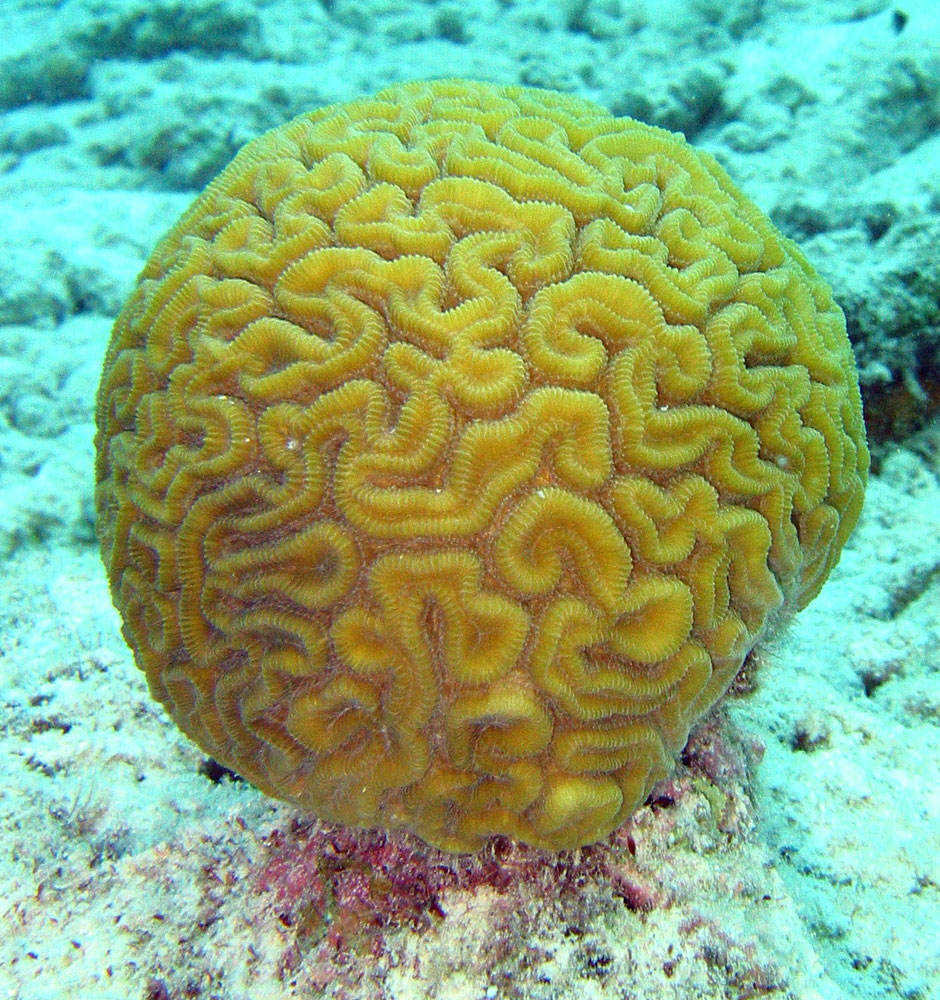[cite journal | last =Stolarski | first =Jaroslaw | authorlink =Jaroslaw Stolarski | coauthors =Anders Meibom, Radoslaw Przenioslo and Maciej Mazur | title =A Cretaceous Scleractinian Coral with a Calcitic Skeleton | journal =Science | volume =318 | issue =5847 | pages =92–94 | publisher =American Association for the Advancement of Science | location =USA | date =2007-10-05 | url =http://www.sciencemag.org/cgi/content/short/318/5847/92 | doi =10.1126/science.1149237 | accessdate =2007-10-11 | pmid =17916731] ]The skeleton of an individual scleractinian polyp is known as a corallite. Each of its radially-aligned elements, termed septa, lies in the endocoel flanked by the members of a mesenterial pair. The skeleton originates as a thin basal plate from which the septa arise vertically. The structure of both simple and compound scleractinians is light and porous, rather than solid as in the Rugosa.
Septa are secreted by the mesenteries and are therefore added in the same order as the mesenteries. As a result, septa of different ages are adjacent to one another, and the symmetry of the scleractinian skeleton is radial or biradial. This pattern of septal insertion is termed "cyclic" by paleontologists. By contrast, in some fossil corals, adjacent septa lie in order of increasing age, a pattern that is termed serial and that produces a bilateral symmetry. Scleractinians are distinguished from the Rugosa also by their pattern of septal insertion. They secrete an aragonitic exoskeleton in which the septa are inserted between the mesenteries in multiples of six.
In scleractinians, there are two main secondary structures:
* Stereome is an adherent layer of secondary tissue, which covers the septal surface. It consists of transverse bundles of aragonitic needles and protects the scleractinians. However, its function can be nullified by the thickening of the septa itself.
* Coenosteum is a perforated complex tissue that separates individual corallites in a compound scleractinians.
At the beginning of Scleractinia’s development four groups with different microstructure can distinguished. These are:
* Pachytecal: Corals having very thick wall and rudimentary septa. This is the group which probably originated from Rugosa corals.
* Thick Trabecular: Corals with septa built from thick structures, resembling little beams, called trabecules.
* Minitrabecular: Corals with septa built from thin trabecules.
* Fascilcular or non-trabecular: Corals with septa not built from trabecules, but from columns being bunches of aragonite fibres...
Ecology and life history
Scleractinians fall into one of two main categories:
* Zooxanthellate
* Non-zooxanthellate
In zooxanthellate corals, the endodermal cells are replete with symbiotic algae. These symbionts benefit the corals because nearly 95% of the organic carbons produced by zooxanthellae are used as food by the polyps. The oxygen byproduct of photosynthesis and additional energy derived from sugars produced by zooxanthallae enable these corals to grow as much as three times faster than if they had no symbionts present. These corals are restricted to shallow (less than 200 feet - 60 meters), well-lit, warm water with moderate to brisk turbulence and abundant oxygen and prefer firm, non-muddy surfaces on which to settle.
Non-zooxanthellate corals are usually non-reef formers and can be found most abundantly beneath about 500 m of water. They thrive at much colder temperatures and can live in total darkness deriving their energy from the capture of plankton and suspended organic particles. The growth rates of most species of non-zooxanthellate corals are significantly slower than those of their counterparts, and the typical structure for these corals is less calciferous and more susceptible to mechanical damage than that of zooxanthellate corals.
Life history
There are two main controls on the form of a scleractinian colony. One is the mode of budding and the other is the relative growth rate. There are two types of budding: intratentacular and extratentacular. In an "intratentacular budding", polyps are divided by simple fission across the stomodaeum, and each bud retains part of the original stomodaeum and regenerates the rest. "Extratentacular budding" takes place outside the tentacular ring of the parent. These daughter buds do not share any part in the functions within the parent scleractinians as do the products of intratentacular budding.
Evolutionary history
There are two main hypotheses about the origin of Scleractinia. The closest scleractinian analog in the Paleozoic is the Rugosa, which suggests direct, possibly polyphyletic, descent, with different scleractinian suborders having originated in different rugosan families. The second hypothesis suggests the similarities of scleractinians to rugosans are due to a common non-skeletalized ancestor in the early Paleozoic. Recently discovered Paleozoic corals with aragonitic skeletons and cyclic septal insertion - two features that characterize Scleractinia - have strengthened the hypothesis for an independent origin of the Scleractinia.
See also
* Ivory Bush Coral
References
Bibliography
* [http://tolweb.org/tree?group=zoantharia Tree of Life - zoantharia]
*cite journal |last=Ezaki |first=Yoichi |authorlink= |coauthors= |year=1998 |month= |title=Paleozoic Scleractinia: progenitors or extinct experiments? |journal=Palaeobiology |volume=24 |issue=2 |pages=227–234 |doi=10.2307/2401240 |url= |accessdate= |quote=

